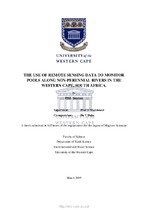| dc.description.abstract | The lack of monitoring of non-perennial rivers is a major problem for water resources
management, despite their significance in satisfying agricultural, economic and recreational
needs. Pools in non-perennial rivers are not monitored, due to their remoteness. Remote
sensing offers a promising alternative for the monitoring of changes in water storage in these
pools.
This study aims to assess the extent to which remotely-sensed datasets can be used to monitor
the spatio-temporal changes of water storage of pools along non-perennial rivers in the
Western Cape. The objectives of this study are: (1) to determine a suitable image preprocessing
and classification technique for detecting and monitoring surface water along nonperennial
rivers, and (2) to describe the spatial and temporal changes of water availability of
pools along non-perennial rivers, using remotely sensed datasets.
The Normalised Difference Water Index (NDWI), Modified NDWI (MNDWI), Normalised
Difference Vegetation Index (NDVI), Automated Water Extraction Index for shadowed
(AWEIsh) and non-shadowed regions (AWEInsh) and the Multi-Band Water Index (MBWI)
classification techniques were investigated in this study, using the Sentinel-2 and Landsat 8
datasets. In-situ measurements were used to validate the satellite-derived datasets, while the
use of high resolution aerial photography and Digital-Globe WorldView imagery were
further compared to the results. The results suggested that the NDWI is the most suitable
classification technique for identifying water in pools along non-perennial rivers throughout
the Western Cape. The NDWI applied to the Sentinel-2 Top-of-Atmosphere (TOA)
reflectance dataset had the highest overall accuracy of 85%, when compared to the Sentinel-2
Dark Object Subtraction 1 (DOS1) atmospheric correction, Sentinel-2 Sen2Cor atmospheric
correction, Landsat 8 TOA reflectance and Landsat 8 DOS1 atmospheric correction datasets.
The incorporation of atmospheric correction was shown to eliminate surface water pixels in
many of the smaller pools. | en_US |

